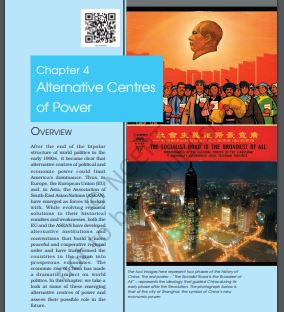‘Alternative Centres of Power NCERT Solutions for Class 12 Political Science Chapter 4‘ PDF Quick download link is given at the bottom of this article. You can see the PDF demo, size of the PDF, page numbers, and direct download Free PDF of ‘Ncert Class 12 Political Science Chapter 4 Exercise Solution’ using the download button.
NCERT Class 12 Political Science Textbook Chapter 4 With Answer PDF Free Download

Chapter 4: Alternative Centres of Power
After the end of the bipolar structure of world politics in the early 1990s, it became clear that
alternative centers of political and economic power could limit America’s dominance.
Thus, in Europe, the European Union (EU), and, in Asia, the Association of South-East Asian Nations (ASEAN), have emerged as forces to reckon with.
While evolving regional solutions to their historical enmities and weaknesses, both the EU and the ASEAN have developed alternative institutions and conventions that build a more peaceful and cooperative regional order and have transformed the countries in the region into prosperous economies.
The economic rise of China has made a dramatic impact on world politics.
In this chapter, we take a look at some of these emerging alternative centers of power and assess their possible role in the future.
As the Second World War came to an end, many of Europe’s leaders grappled with the ‘Question of Europe’.
Should Europe be allowed to revert to its old rivalries or be reconstructed on principles and institutions that would contribute to a positive conception of international relations?
The Second World War shattered many of the assumptions and structures on which the European states had based their relations.
In 1945, the European states confronted the ruin of their economies and the destruction of the assumptions and structures on which Europe had been founded.
European integration after 1945 was aided by the Cold War. America extended massive financial help for reviving Europe’s economy under what was called the ‘Marshall Plan.
The US also created a new collective security structure under NATO. Under the Marshall Plan, the Organisation for European Economic Cooperation (OEEC) was established in 1948 to channel aid to the west European states.
The Council of Europe, established in 1949, was another step forward in political cooperation.
The process of the economic integration of European capitalist countries proceeded step by step (see Timeline of European Integration) leading to the formation of the European Economic Community in 1957.
This process acquired a political dimension with the creation of the European Parliament.
The collapse of the Soviet bloc put Europe on a fast track and resulted in the establishment of the European Union in 1992.
The foundation was thus laid for a common foreign and security policy, cooperation on justice and home affairs, and the creation of a single currency.
| Author | NCERT |
| Language | English |
| No. of Pages | 14 |
| PDF Size | 3 MB |
| Category | Political Science |
| Source/Credits | ncert.nic.in |
NCERT Solutions Class 12 Political Science Chapter 4 Alternative Centres of Power
1. How has the European Union evolved over time from an economic union to an increasingly political one?
Answer: The European Union has evolved over time from an economic union to an increasingly political one.
The EU has started to act more as a nation-state. While the attempts to have a constitution for the EU have failed, it has its own flag, anthem, founding date, and currency.
It also has some form of a common foreign and security policy in its dealings with other nations. The European Union has tried to expand areas of cooperation while acquiring new members, especially from the erstwhile Soviet bloc.
The process has not proved easy, for people in many countries are not very enthusiastic in giving the EU powers that were exercised by the government of their country. There are also reservations about including some new countries within the European Union.
2. Explain the political, and diplomatic influence of the European Union as a supernational organisation.
Answer: Political and Diplomatic Influences:
(a) Two members of the EU — Britain and France hold permanent seats in the Security Council to influence the UN policies.
(b) The EU also includes various non-permanent members of the UNSC.
(c) The European Union plays an influential role in diplomacy and negotiations except for the military force
i. e. the EU’s dialogue with China on human rights and environmental degradation is remarkable.
3. What led to the evolution of the EU from an economic union to an increasingly political one?
Answer: The European Union has now started to act more as a nation-state because-
(i) European Union has its own flag, anthem, founding date and common currency.
(ii) European Union bears common foreign and security policy.
(iii) The EU has made efforts to expand areas of cooperation while acquiring new members especially from the Soviet bloc.
4. What are the objectives behind the formation of ASEAN?
Answer: The objectives behind the formation of ASEAN are as follows:
1. Territorial disputes should not escalate into armed confrontations.
2. To accelerate economic growth through social progress and cultural development.
3. To promote regional peace and stability based on the rule of law and the principles of the United Nations; charter.
4. To establish a Dispute Settlement Mechanism to resolve economic disputes.
5. To create Free Trade Areas for investment, labour and services.
5. Describe any four significant characteristics of ASEAN.
Answer: 1. To create a common market and production-based activities within the ASEAN States.
2. To aid social and economic development.
3. To resolve economic disputes, the existing dispute settlement mechanism has been improved.
4. Free Trade Areas for investment, labor, and services have also been created.
Alternative Centres of Power NCERT Textbook With Solutions PDF Free Download
